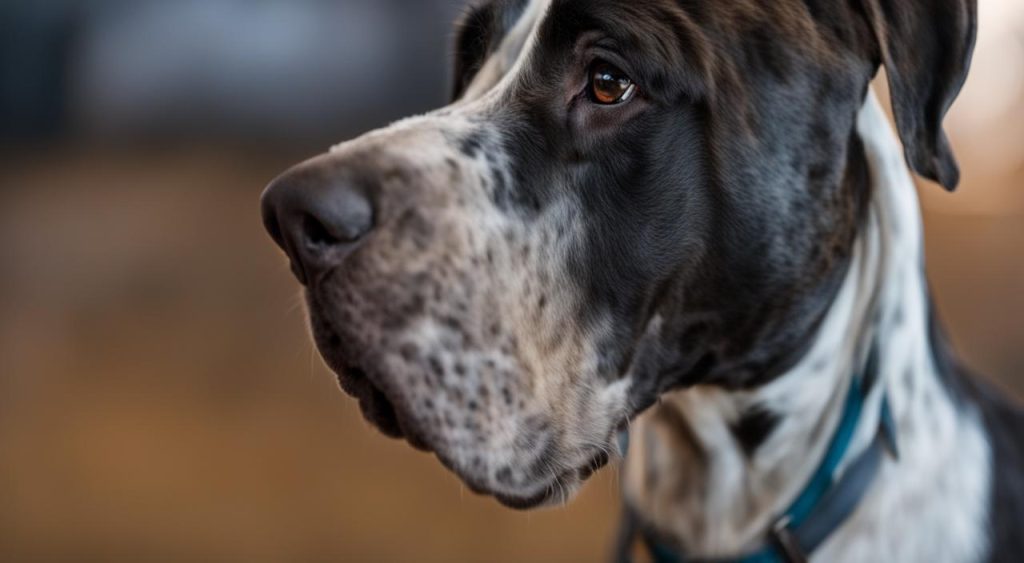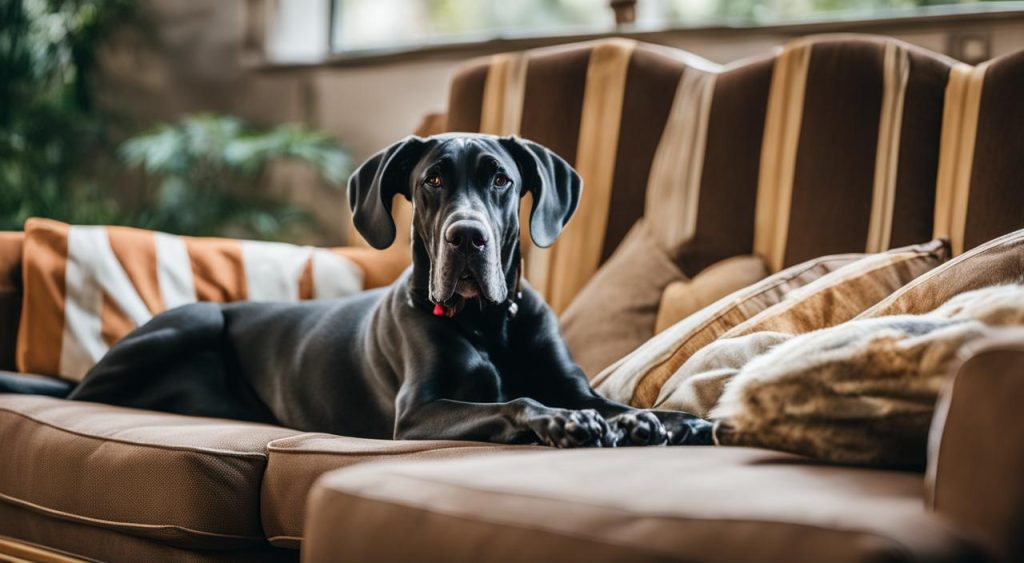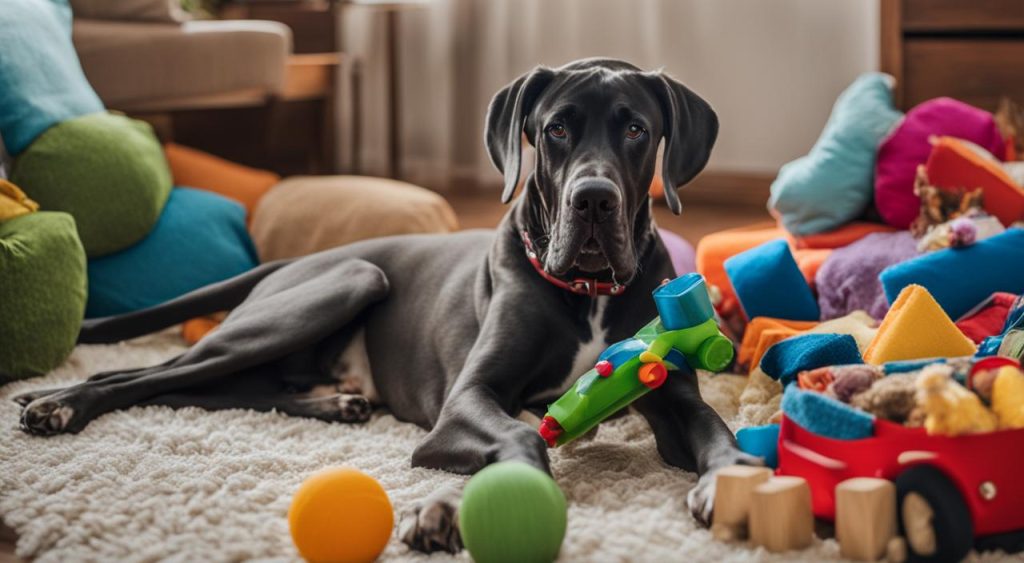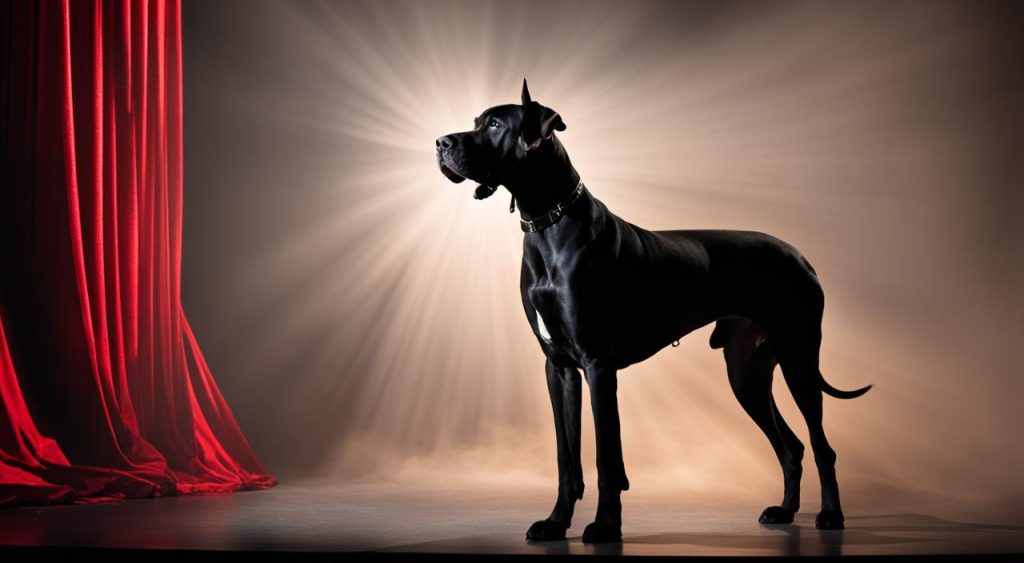If you’re considering getting a dog and have allergies, you may be wondering if Great Danes are hypoallergenic. Unfortunately, Great Danes are not considered hypoallergenic dogs.
When it comes to allergens, it’s not the fur itself that causes the reaction, but rather the pet dander, which consists of microscopic dead skin cells, that attaches to the fur. While no dog is truly 100% hypoallergenic, hypoallergenic dogs are low shedders, releasing less dander in the home.
Great Danes have a single coat of fur, not a double coat like heavy shedding dogs, but their large size still results in a significant amount of loose hair. Additionally, the protein found in dander is also present in dog saliva, so dogs that drool, like Great Danes, could cause additional allergic reactions for those with dog allergies.
Key Takeaways:
- Great Danes are not considered hypoallergenic dogs.
- Hypoallergenic dogs are low shedders, releasing less dander in the home.
- Great Danes have a single coat of fur and shed less than heavy shedding dogs, but their size still results in a significant amount of loose hair.
- Great Danes that drool can cause additional allergic reactions due to the allergenic protein present in dog saliva.
- Allergy sufferers may need to implement management techniques to live comfortably with Great Danes.
Why Do Great Danes Cause Allergic Reactions?
Great Danes cause allergies due to their shedding of fur, which is the primary source of pet dander. It is important to note that it is the dander itself, not the hair, that triggers allergies in humans.
Although Great Danes have a single coat and shed less than some larger breeds, their size still results in a significant amount of loose hair. This loose hair carries dander, which can easily become airborne and cause allergic reactions in sensitive individuals.
“Pet dander consists of tiny particles shed from an animal’s skin, fur, or feathers. These particles contain proteins that can trigger allergic reactions.”
In addition to shedding, Great Danes have a tendency to drool, which can further contribute to allergic reactions. The allergenic protein found in dander is also present in dog saliva. This means that individuals who are allergic to dogs may experience symptoms when coming into contact with a Great Dane’s saliva.
For allergy sufferers, the effects of dander on their health can range from mild discomfort to severe respiratory distress.
“Exposure to pet dander can cause symptoms such as sneezing, nasal congestion, itchy and watery eyes, coughing, wheezing, and shortness of breath in individuals with allergies.”
Factors That Contribute to Excessive Shedding in Great Danes
Great Danes may experience excessive shedding, and there are several factors that can contribute to this issue. One common cause is poor nutrition, which can lead to dry skin and a dull, coarse coat of fur, ultimately resulting in increased shedding. Providing your Great Dane with a balanced and nutritious diet is essential for maintaining a healthy coat and reducing excessive shedding.
Stress is another factor that can trigger excessive shedding in Great Danes. Just like humans, dogs can also experience stress, and it can impact their overall health and coat condition. If your Great Dane is going through a stressful period, such as changes in the household or routine, it’s important to provide them with a calm and stable environment to help alleviate their stress levels.
Parasitic infestations can also contribute to excessive shedding in Great Danes. Fleas, ticks, lice, and mites are common parasites that can cause skin irritation and lead to increased shedding. Regular preventative measures such as flea and tick control treatments, along with routine grooming practices, can help prevent these infestations and reduce shedding.
Hormonal disorders, such as Cushing’s disease, can affect the amount of shedding in dogs, including Great Danes. If your Great Dane is shedding excessively and there are no obvious causes, it’s crucial to consult with a veterinarian. They can conduct tests to rule out any hormonal disorders and provide appropriate treatment if necessary.
“Proper nutrition, stress management, parasite prevention, and regular veterinary check-ups are essential for maintaining a healthy coat and minimizing excessive shedding in Great Danes.”
Managing Allergies with Great Danes
Although Great Danes are not hypoallergenic, there are effective strategies that can be implemented to manage allergies while living with these majestic dogs. By incorporating a few key practices, you can reduce allergens and create a more comfortable environment for both you and your Great Dane.
Brushing and Bathing
Regular brushing is essential for managing allergies with Great Danes. It helps to remove loose hair and dander, preventing them from spreading throughout your home. Use a high-quality brush designed for pet hair to effectively capture and remove allergens. Additionally, occasional bathing can also help wash away loose hair and further reduce allergens.
Proper Nutrition
Ensuring your Great Dane receives a balanced and nutritious diet is important for maintaining a healthy coat and minimizing shedding. Consult with your veterinarian to determine the best food options to promote a healthy coat and reduce allergens.
Cleaning Strategies
Regular cleaning is crucial when managing allergies with Great Danes. Use a vacuum cleaner specifically designed for pet hair to thoroughly remove allergens from carpets, upholstery, and other surfaces. In addition, consider using air purifiers with HEPA filters to capture and eliminate pet dander in the air.
Lifestyle Adjustments
Making certain lifestyle adjustments can also help minimize exposure to allergens. Train your Great Dane to stay off furniture and establish designated areas in your home where your dog is not allowed. By restricting access to these areas, you can create allergy-safe spaces in your home.
Remember, managing allergies with Great Danes requires a multifaceted approach. Regular brushing and bathing, proper nutrition, effective cleaning strategies, and lifestyle adjustments can significantly reduce allergens and create a more comfortable living environment for allergy sufferers.
Are Great Danes Hypoallergenic or Not?
Great Danes are not considered hypoallergenic dogs. They do shed, which can trigger allergies in sensitive individuals. However, if you are an allergy sufferer, you can still live comfortably with a Great Dane by implementing proper management techniques.
Regular brushing is essential to remove loose hair and dander from your Great Dane’s coat. This helps to minimize the allergens that can cause reactions. Occasional bathing can also be helpful in washing away loose hair and reducing dander in your home.
In addition, providing a high-quality diet for your Great Dane can contribute to a healthy coat and skin, which can help minimize shedding. Regular cleaning and vacuuming, especially with a vacuum designed for pet hair, can also help to reduce allergens in your living space.
Using air purifiers with HEPA filters can further aid in removing pet dander from the air. Making lifestyle adjustments, such as training your Great Dane to stay off furniture and restricting access to certain areas of your home, can also help minimize exposure to allergens.
While hypoallergenic dog breeds may be a better fit for individuals with severe allergies, with proper management techniques, allergy sufferers can still live with moderate to heavy-shedding breeds like Great Danes. By following these tips and maintaining a clean and allergy-friendly environment, you can enjoy the companionship of a Great Dane without compromising your comfort.





